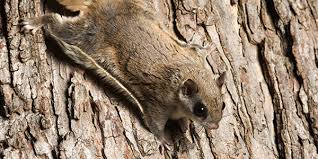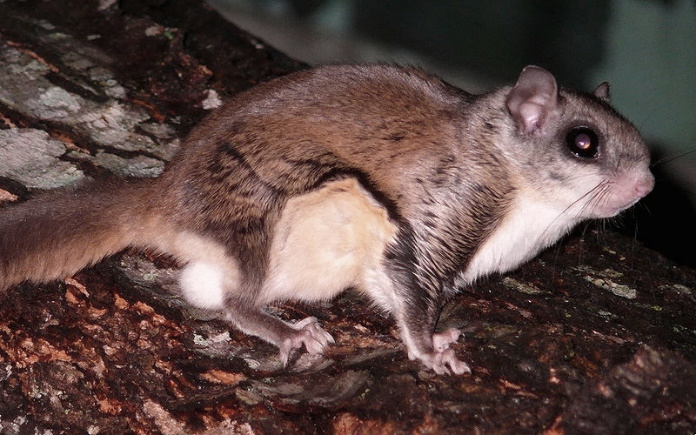Baker: So why are flying squirrels fluorescent pink?

Every forest east of the Mississippi and north of the U.S.-Canadian border abounds in tiny hot-pink squirrels.
Now, it’d be one thing to persuade you that such a patently batty notion is true (it is), but quite another to spool out a convincing answer to the question, “Why are they pink?”
Ecologists generally find “who, what, when, where, and how” questions about the living world reasonably manageable to address. Such questions fall under the heading of Descriptive Ecology, the identification of patterns in nature.
Examples:
What were the most common species of trees in the Northeast prior to the Pleistocene Ice Ages?
When do Eastern red bats in Ontario migrate south for the winter?
How do Chinook salmon find their way back up the Columbia River after spending two years in the Pacific Ocean?
Not necessarily easy questions to tackle but do-able, given enough time and resources.
But to definitively answer “why” the species composition of pre- and post-Pleistocene forests differed, why Canadian red bats migrate but little brown bats don’t, or why a salmon would migrate a thousand miles up the Columbia just to spawn and die in some small creek in Alberta …you’d have to know pretty much everything there is to know about all of these organisms and the environments in which they live.
Not possible.
But if we can never be 100% sure we understand the underlying cause for any given aspect of nature, we can still develop reasonable hypotheses (the scientific name for testable guesses) in that direction. Identifying the existence of a pattern in nature is just the first step in an ecological research program. Working on the possible reasons that pattern exists — sometimes called Functional Ecology — can be a lot more challenging.
Case in point: In May 2017, Dr. Jonathan Miller of Northland College, was conducting a nocturnal survey of spring plants and lichens around the backyard of his Northern Wisconsin home, which abuts a wooded area. He was using a handheld ultraviolet flashlight because many of the species he was interested in are known to fluoresce under UV light.

Miller was startled when a bright pink squirrel flew through the light’s purple beam to land on one of his bird feeders. It was a Southern flying squirrel (Glaucomys volans), and the moment he moved his light off of the animal, its pink coloration vanished.
That chance observation led to a research paper published in 2019 that reported bright pink fluorescence in over 100 museum specimens of flying squirrels obtained from across North America. The phenomenon was observed on the upper and lower surfaces of both males and females for each of North America’s three species of flying squirrels, although the belly and undersurface of the tail generally shone most brightly.
So of course, the next questions are how common is fluorescence in animals and why do these squirrels exhibit a color that can only be seen under UV illumination?
Why, indeed.
Although fluorescence under UV light (in diverse shades) has been observed in a wide range of plants and animals — including various fish, amphibians, reptiles, and birds among the vertebrates — the only other mammals known to exhibit fluorescence, before this discovery, were several species of opossums. (More recently, it’s also been observed in the Tasmanian devil and platypus.)
Fluorescent fur has not been found in any other group of North American rodents. So what’s different about flying squirrels?
Well, besides their ability to sail between trees on a flap of skin stretching from wrist to ankle — despite their name, they can only glide, not fly — the Southern, Northern, and Humboldt’s flying squirrels are our only species of squirrels that are active at night.
It’s been observed that in the deciduous and mixed forest habitats these small (8 to 12 inches) squirrels prefer, the low light conditions at dawn and twilight when they are especially active, are commonly dominated by UV light. Furthermore, they are active year-round and in the northern parts of their range; snow reflects a good deal of UV.
One hypothesis is that their fluorescent coloration may help camouflage them against predators like owls (which can detect UV) by blending against similarly fluorescing plants and lichens. Alternatively, it may play some unknown role in communication and mating.
It’s suggestive that the lens covering a flying squirrel’s eye allows UV radiation to pass through to the retina, unlike the lenses of our other squirrels.
On the other hand, Dr. Michael Bok, a visual systems biologist with Lund University in Sweden, has said it would be “incredibly surprising” if the animals “could make out these fluorescent patterns in any sort of natural lighting environment.”
So maybe their fluorescence is just a side effect of how the squirrels’ fur is constructed, providing them no adaptive value at all. Maybe.
On YouTube, search for “Pink Flying Squirrels on Fox News” for some of the best video since Rocky and Bullwinkle went off air in 1964.
Ken Baker is a retired professor of biology and environmental studies. If you have a natural history topic you would like Dr. Baker to consider for an upcoming column, please email your idea to fre-newsdesk@gannett.com.
This article originally appeared on Fremont News-Messenger: Baker: So why are flying squirrels fluorescent pink?
